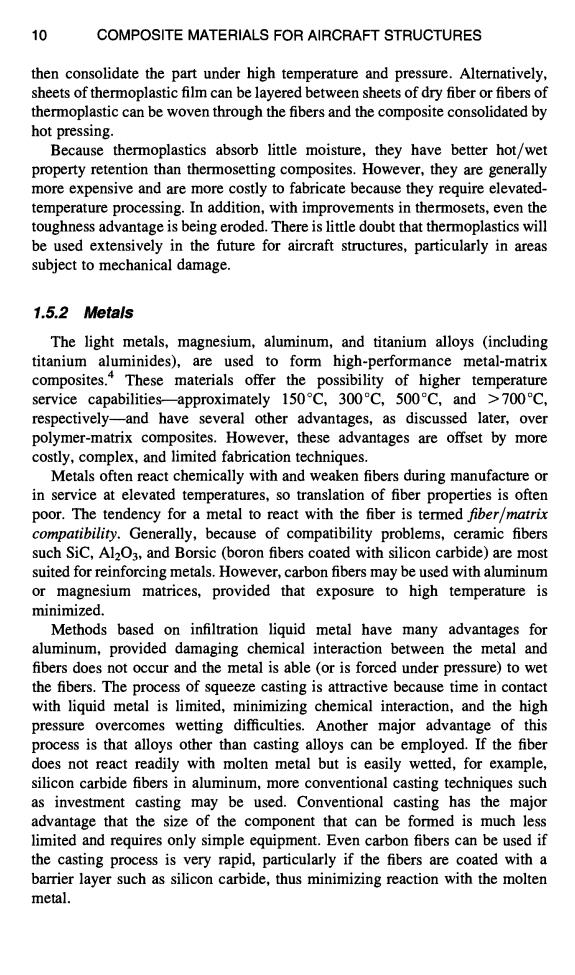正在加载图片...

10 COMPOSITE MATERIALS FOR AIRCRAFT STRUCTURES then consolidate the part under high temperature and pressure.Alternatively, sheets of thermoplastic film can be layered between sheets of dry fiber or fibers of thermoplastic can be woven through the fibers and the composite consolidated by hot pressing. Because thermoplastics absorb little moisture,they have better hot/wet property retention than thermosetting composites.However,they are generally more expensive and are more costly to fabricate because they require elevated- temperature processing.In addition,with improvements in thermosets,even the toughness advantage is being eroded.There is little doubt that thermoplastics will be used extensively in the future for aircraft structures,particularly in areas subject to mechanical damage. 1.5.2 Metals The light metals,magnesium,aluminum,and titanium alloys (including titanium aluminides),are used to form high-performance metal-matrix composites.4 These materials offer the possibility of higher temperature service capabilities-approximately 150C,300C,500C,and >700C, respectively-and have several other advantages,as discussed later,over polymer-matrix composites.However,these advantages are offset by more costly,complex,and limited fabrication techniques. Metals often react chemically with and weaken fibers during manufacture or in service at elevated temperatures,so translation of fiber properties is often poor.The tendency for a metal to react with the fiber is termed fiber/matrix compatibility.Generally,because of compatibility problems,ceramic fibers such SiC,Al2O3,and Borsic(boron fibers coated with silicon carbide)are most suited for reinforcing metals.However,carbon fibers may be used with aluminum or magnesium matrices,provided that exposure to high temperature is minimized. Methods based on infiltration liquid metal have many advantages for aluminum,provided damaging chemical interaction between the metal and fibers does not occur and the metal is able (or is forced under pressure)to wet the fibers.The process of squeeze casting is attractive because time in contact with liquid metal is limited,minimizing chemical interaction,and the high pressure overcomes wetting difficulties.Another major advantage of this process is that alloys other than casting alloys can be employed.If the fiber does not react readily with molten metal but is easily wetted,for example, silicon carbide fibers in aluminum,more conventional casting techniques such as investment casting may be used.Conventional casting has the major advantage that the size of the component that can be formed is much less limited and requires only simple equipment.Even carbon fibers can be used if the casting process is very rapid,particularly if the fibers are coated with a barrier layer such as silicon carbide,thus minimizing reaction with the molten metal.10 COMPOSITE MATERIALS FOR AIRCRAFT STRUCTURES then consolidate the part under high temperature and pressure. Alternatively, sheets of thermoplastic film can be layered between sheets of dry fiber or fibers of thermoplastic can be woven through the fibers and the composite consolidated by hot pressing. Because thermoplastics absorb little moisture, they have better hot/wet property retention than thermosetting composites. However, they are generally more expensive and are more costly to fabricate because they require elevatedtemperature processing. In addition, with improvements in thermosets, even the toughness advantage is being eroded. There is little doubt that thermoplastics will be used extensively in the future for aircraft structures, particularly in areas subject to mechanical damage. 1.5.2 Metals The light metals, magnesium, aluminum, and titanium alloys (including titanium aluminides), are used to form high-performance metal-matrix composites. 4 These materials offer the possibility of higher temperature service capabilities--approximately 150°C, 300°C, 500°C, and >700°C, respectively--and have several other advantages, as discussed later, over polymer-matrix composites. However, these advantages are offset by more costly, complex, and limited fabrication techniques. Metals often react chemically with and weaken fibers during manufacture or in service at elevated temperatures, so translation of fiber properties is often poor. The tendency for a metal to react with the fiber is termed fiber/matrix compatibility. Generally, because of compatibility problems, ceramic fibers such SiC, A1203, and Borsic (boron fibers coated with silicon carbide) are most suited for reinforcing metals. However, carbon fibers may be used with aluminum or magnesium matrices, provided that exposure to high temperature is minimized. Methods based on infiltration liquid metal have many advantages for aluminum, provided damaging chemical interaction between the metal and fibers does not occur and the metal is able (or is forced under pressure) to wet the fibers. The process of squeeze casting is attractive because time in contact with liquid metal is limited, minimizing chemical interaction, and the high pressure overcomes wetting difficulties. Another major advantage of this process is that alloys other than casting alloys can be employed. If the fiber does not react readily with molten metal but is easily wetted, for example, silicon carbide fibers in aluminum, more conventional casting techniques such as investment casting may be used. Conventional casting has the major advantage that the size of the component that can be formed is much less limited and requires only simple equipment. Even carbon fibers can be used if the casting process is very rapid, particularly if the fibers are coated with a barrier layer such as silicon carbide, thus minimizing reaction with the molten metal